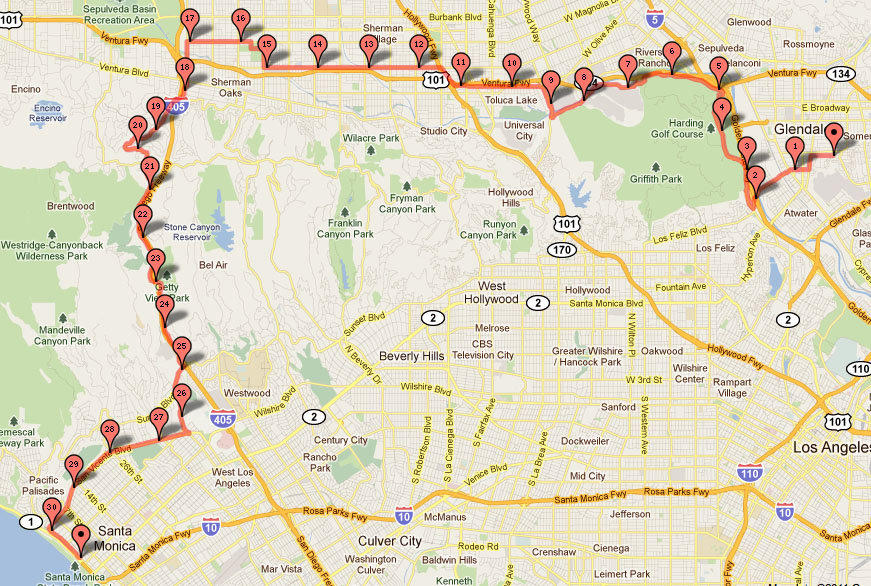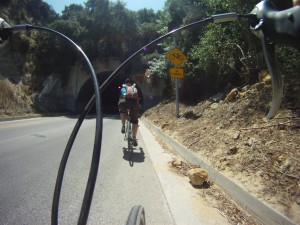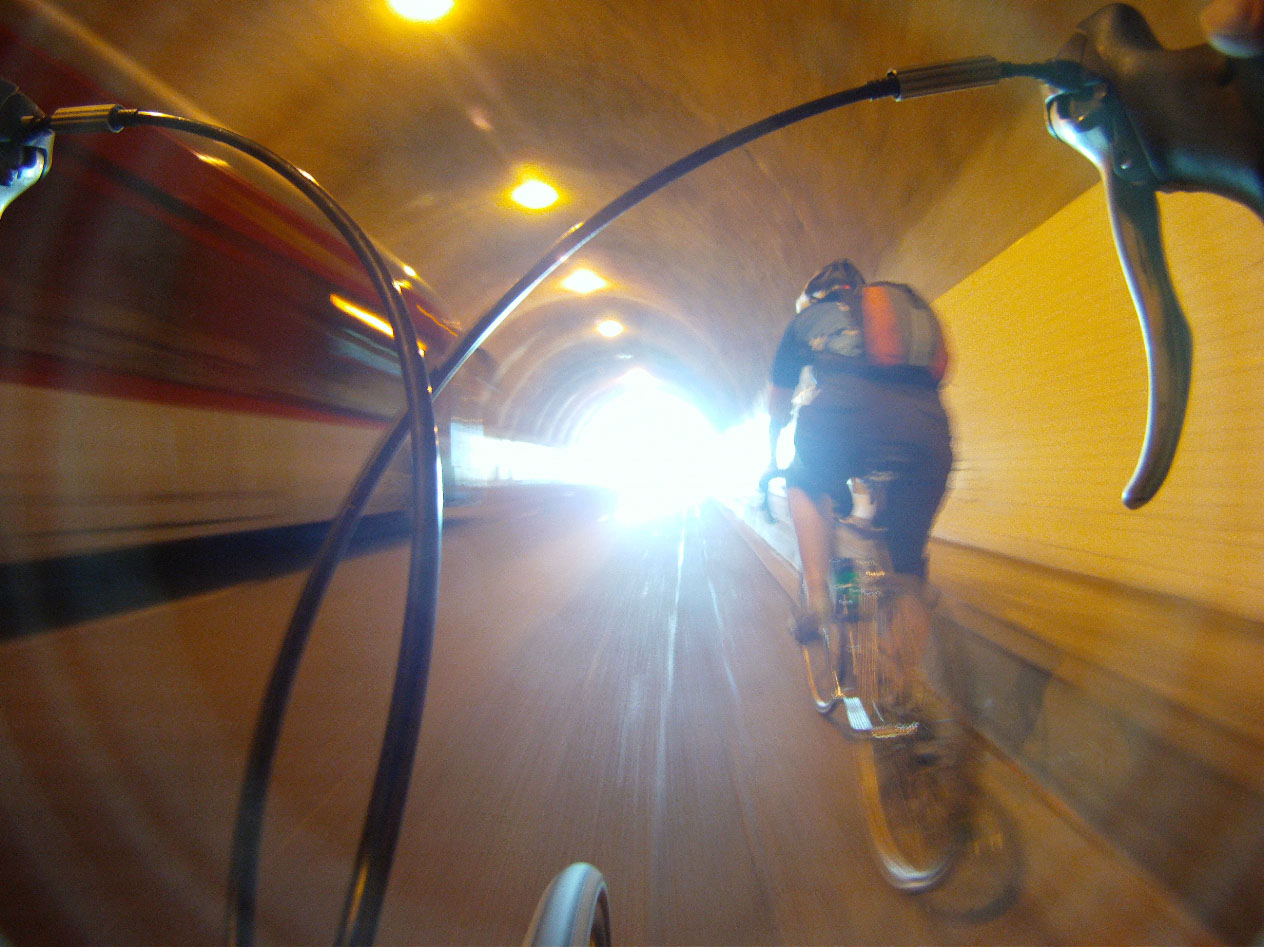The second time in my life that I biked up and over the Sepulveda Pass was last weekend during my Autocalypse Now Ride. The first time? Waaaay the hell back in 1991. I remember it well because it was a rather epic ride. The woman I was dating at the time had decided to go to the beach in Santa Monica with her daughter, and since I’d already been planning on biking from my apartment in Glendale to a morning softball game in Sherman Oaks, I thought what the hell and decided to bike the rest of the way to the sea.
 Think about that for a second: Glendale to Sherman Oaks to Santa Monica. Roughly 31 miles. With a league softball game in the middle. Twenty years ago. Pardon me for crowing a bit about it.
Think about that for a second: Glendale to Sherman Oaks to Santa Monica. Roughly 31 miles. With a league softball game in the middle. Twenty years ago. Pardon me for crowing a bit about it.
Of course the trek was predicated on my crossed-fingered hope that I would somehow be able to locate my girfriend on the crowded sands somewhere between a pair of predetermined lifeguard stations. If so, I could throw the bike in her trunk for a drive home. If not, it was going to be a long and exhausting ride back to Glendale.
Much to my relief I found her. But that successful conclusion is not the point. The point is that from a bicycling perspective of Sepulveda Boulevard between the two decades that separated my riding it, we’ve come a long way, baby. Both literally and figuratively, with some of it good and some of it leaving a helluva lot to be desired.
When I got on my bike last weekend, the vast majority of the ride from Silver Lake to the top of the Sepulveda Pass was done over a nice mix of Class I bikeways and Class II bike lanes. We had the LA River and Chandler bikeways connected mostly by the Riverside Drive bike lanes. Then the Chandler bike lanes to the Orange Line Bikeway. South of Ventura a bike lane’s been laid down almost to the top. And that bad little bit o’ almost is what I want to focus on.
But before I do, in salute to the good that’s been laid down, let’s remember that in 1991 there was no LA River or Chandler or Orange Line bikeways. There may have been a Riverside Drive bike lane, but there certainly wasn’t a striped lane on Sepulveda.
 So I was cheering and marveling all along that first 27 miles from Silver Lake up through Sherman Oaks, but I quit rah-rah’ing just as we were arriving at the three-lane Sepulveda Tunnel when the bike lane abruptly ended, leaving me entering the tunnel with fellow rider Ann past a dark signal light above a Bike sign which hung above an “In Tunnel” sign (at left, click to enlarge) and wondering what confederacy of dunces decided such an apparently malfunctioning after-thought would suffice in protecting cyclists when they are at their most vulnerable/least visible.
So I was cheering and marveling all along that first 27 miles from Silver Lake up through Sherman Oaks, but I quit rah-rah’ing just as we were arriving at the three-lane Sepulveda Tunnel when the bike lane abruptly ended, leaving me entering the tunnel with fellow rider Ann past a dark signal light above a Bike sign which hung above an “In Tunnel” sign (at left, click to enlarge) and wondering what confederacy of dunces decided such an apparently malfunctioning after-thought would suffice in protecting cyclists when they are at their most vulnerable/least visible.
Inside the tunnel I saw there was a sidewalk to our right to desperately bail out to if needed and I reached back to turn on my rear flasher to provide some type of increased visibility. But about midway through when a procession of vehicles (including an MTA bus, several passenger vehicles and a Super Shuttle van) entered the tunnel behind us, I moved to the middle of the No. 2 lane and decided to forsake any coolness by augmenting my rear light with some serious flapping and waving of my arms in hopes my funkily animated silhouette might draw the drivers’ eyes before they were right on top of us. With two southbound lanes all vehicles cleared us smoothly, except the van which somewhat unnervingly got to about 10 feet behind me before it got a chance to change lanes.
Note: It’s distressing times like that when wheeljockeys blithely steering thousands of pounds of steel up my ass that I wish I had a double-barreled paintball gun with which to level at their heads and splatter their windshields.
Needless to say I was very relieved when we emerged back into the light (and the resurrected bike lane) from the roughly minute-long ordeal, and I shuddered to think how much more harrowing it could and would be for northbound cyclists, what with its single traffic lane and no sidewalk. No, thank you.
Fast forward to the next day after I’d compiled and posted my Autocalypse Now Ride timelapse video to YouTube. As I was slow-scrolling through the frames to pick out individual stills to upload to a companion photoset on Flickr, I was stunned to find the device in the image below (click to enlarge), which showed me that the dead signal light up ahead at the tunnel’s north entrance wasn’t dead at all. Instead, it hadn’t been triggered. By me.
And the reason for that oversight? Let’s call it tunnel vision, pardon the pun. I pedaled by the cycling equivalent of a crosswalk button cloaked a bit in the shade of the adjacent foliage completely oblivious to its existence — and this pissed me off. On two levels. First, because it was a blow to what I’ve always considered a keen sense of awareness of my surroundings. I pride myself on my ability to see things, especially something as unique as this. Second, because it’s a half-baked solution that is yet another example proving the city considers cyclists second class on our streets.
Oh sure! I know that whoever came up with, submitted, went back to the drawing board, resubmitted, got tentative approval pending modifications, resubmitted, approved, got funded and implemented this idea is probably pretty damn proud of themselves. They took an obvious problem of how to include bicycles in a narrow and unexpandable vehicle-exclusive tunnel and found a solution. For its absolute better-than-nothingness if there were a national competition I could see this being a finalist for the Better Than Nothing Project Of The Year.
As keen as I aforementioned myself to be (or at least previously thought I was), I’m going to hazard a guess that I’m not the only cyclist who’s pedaled by this “solution.” Not only that but I’ll bet cyclists who do see it as they crank toward it don’t go to the trouble to stop and push it, opting instead to just leave the blinking beacon lamp unlit and instead take their chances.
The sad thing is there are other solutions. Yep, I missed the one they installed based on however many man-hours spent coming to the foregone conclusion that the only way was to stop the bike lane north the tunnel and start it up just south, but I saw other options that could work in conjunction with the beacon button after passing through the tunnel just once — none of which would require changes to the actual configuration.
Solution No. 1: Install super-bright LED lighting in the tunnel. Brighter illumination 24/7 equals better visibility 24/7.
Solution No. 2: Make the sidewalk readily available to cyclists by installing apron ramps at both ends of the west side of the tunnel, giving them the option of easily getting off the roadway.
Solution No. 3: More “Watch for Cyclists & Pedestrians” and “Share the Road” signage leading up to both ends of the tunnel. And while we’re at it howsabout blinking beacons in the tunnel and a “Cyclists: Beacon Button Ahead” sign a hundred feet or so before the actual button.
Of course those solutions will only make things a bit safer for southbound traveling bikes. If we want to make any northbound cyclists and pedestrians feel more like they’re a part of the program (rather than forcing them to consider crossing the road), my solution would be infinitely more extensive, involving the removal of the west side sidewalk, putting the tunnel on a road diet down from three lanes to two (or at least narrowing the width of each of the three lanes, and adding pedestrian/cyclist lanes on either side, either elevated or barriered.
No doubt a dozen reasons against such suggestions could be cited by the champions of Better Than Nothing. Because those suggestions are much, much more than that. They’re solutions, not compromises.


 Follow
Follow